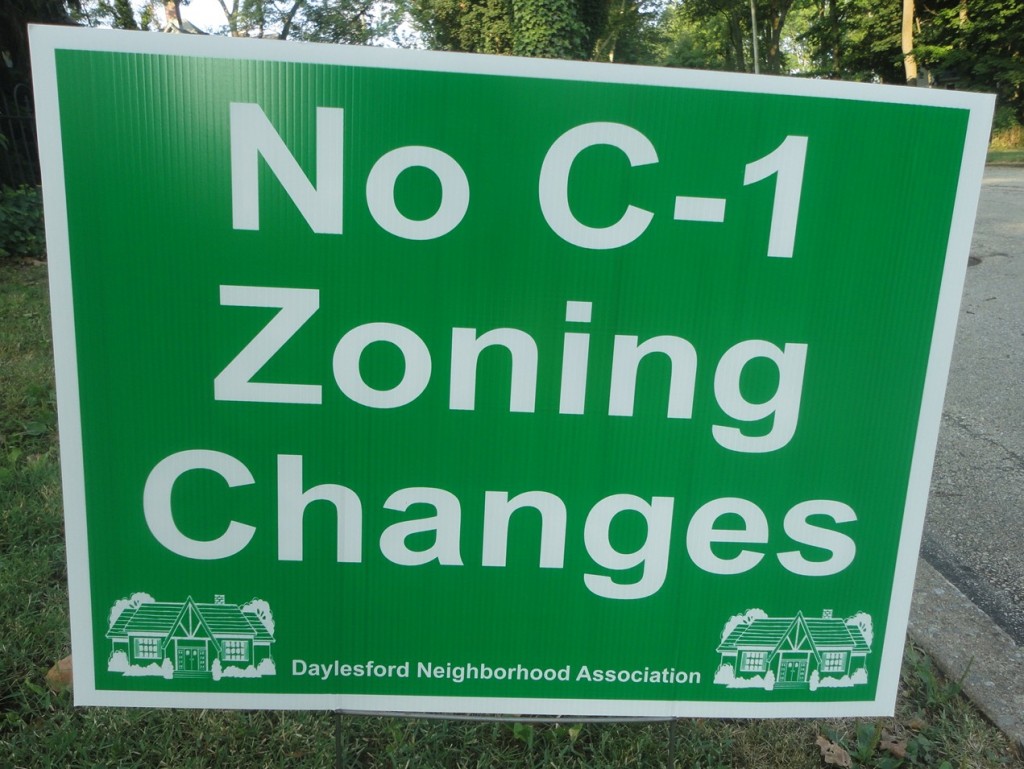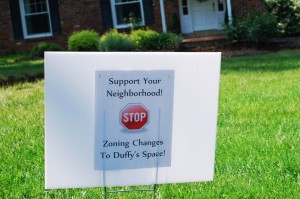This is provided as a follow-up to last night’s presentation at the Planning Commission meeting on the planned assisted living project at the Jimmy Duffy’s site.
The sketch plan for the new assisted living facility presented by Kelly Cook Andress, President of Sage Senior Living Development, had some notable changes from the original Capital Health plan of 2012. Gerald Farrell of Capital Health, developer Ed Morris and their attorney Denise Yarnoff attended numerous Planning Commission meetings and community meetings with neighbors and concerned citizens during 2012. These meetings were the precursor to the township changing CI zoning to permit assisted living as a usage.
Up until the agenda for the Planning Commission meeting was released, we assumed that Capital Health was the owner. There was no reference last night as to when Sage Senior Living came into the picture or why Capital Health was no longer involved. However, Denise Yarnoff and Ed Morris do remain as the attorney and developer, respectfully, working now with Andress on the Sage project.
Although the information was not provided at the meeting, according to Caroline O’Halloran’s Main Line Media News article, Eagle National Bank sold the property to Capital Health on March 29, 2013 for $2.25 million and then immediately ‘flipped’ the property to Sage Senior Living sometime in the last 3 weeks.
When originally presented to residents by Ed Morris in early 2011, the proposed project was described as a ‘retirement’ facility for seniors … a place for local residents to downsize from their large homes but remain in Tredyffrin Township. I recall Morris initially suggested that many of the residents would have their own cars and be driving in the community. As the project moved forward, Morris backed off the idea that most of the residents at the facility would be driving — he probably realized that by promoting that residents would be driving also meant they would have cars; and cars would mean greater parking requirements on the site.
Last night, Andress painted a very different picture of the project, stating that the average age of people moving in to the proposed assisted living facility would be 86 years, not the ‘empty nesters’ of the earlier plan. She spoke of her Towson, MD facility, similar in size to the 78-80 units planned for the Duffy site. At her Towson facility, only 2 of the residents still have drivers licenses and only one of them has a car. Andress used the rationale of so few drivers as the reason that Sage Senior Living would not need the required parking. She spoke of the stricter
How many parking spaces does Andress need for her Sage Senior Living project? Here’s the applicable township zoning regulation:
§208-103 Off-Street Parking
(23) Residential care facilities for older persons and skilled nursing facilities: one parking space per two permanent beds approved unless otherwise a greater number is determined by the Zoning Officer after taking into consideration the number of units, occupancy per unit and number of employees.
Looking at Andress’ plan for 78-80 units (and assuming only one bed per unit) at a minimum, this assisted living facility requires 39-40 parking spaces. The C1 zoning for assisted living permits a facility to have 100 beds, which would require a minimum of 50 parking spaces. Although the adjacent VetCare has parking, those parking spaces cannot be included in the development project. The sketch plan indicated 37 parking spaces, which falls short of the township required parking.
The earlier assisted living facility plan required the use of the R1 zoning parcel to meet the parking requirement. Andress’ plan show
Several times during the Sage Senior Living presentation, Andress referred to sub-committee meetings with Planning Commissioners. It was unclear from the meeting which commissioners were part of this sub-committee although Commissioner Tory Snyder referenced these prior discussions in her comments to the applicant. As an audience member, it was very confusing to follow the references to these non-public meetings.
Due to weather, Daylesford Neighborhood Association President Trisha Larkin was delayed in Chicago and unable to attend the Planning Commission meeting. Trish provided the following statement to Community Matters:
Unfortunately my flight was delayed yesterday and I couldn’t attend the meeting. However, I was briefed by several residents and here are our top concerns:
1. When C-1 zoning was changed last Fall to include ALF use, it was all predicated on the OLD owner’s vision and site plan. Last night, the new owner (Sage) proposed a much different vision and perhaps a more “institutional” use than what was approved for Capital Health by the BoS. The “lock-down/underground” dementia/Alzheimer’s Unit that Sage has in mind leaves us questioning if the PA Code allows for such use in C-1? It seems that more discovery should take place to determine if such use is permitted in C-1.
2. § 208-103 Off-Street Parking Facilities. Perhaps Sage is under the impression that supplying enough parking in the C-1 space is optional vs. mandatory. Tredyffrin Township Zoning Code 208-103 states they must provide 1 parking space per 2 permanent beds. This has been the DNA’s point for over a year – the Duffy space is entirely too small for this project.
If Sage chooses to put that many beds (78 – 100) on 1 acre, then they MUST provide a minimum of 39 parking spaces. It’s irrelevant if the average resident is 86 and doesn’t drive. Zoning laws are zoning laws! Tredyffrin already did Ed Morris a solid and changed C-1 zoning for this project. Now what? The PC, BoS and Zoning Health Board should just whimsically reduce the # of parking spaces required too? Seriously? You can’t have it both ways! 39 spaces are needed to safely accommodate employees, visitors, residents, deliveries, physicians stopping in to provide care, rehab nurses, etc.
It’s my understanding that Dr. Rowan of Paoli Vet Care was adamant at the PC meeting that he doesn’t intend to “share” his allotted 15 spaces with Sage. Therefore, Sage should not include those spots in their June site plan.
So, the DNA asks (again) – HOW can Sage build the facility, the parking, picnic areas, etc. all on ONE acre of C-1 space?
Easy – they’ll ask the PC and BoS to “borrow” from the one acre of R-1! Although the current sketch plan showed the R-1 parcel as “green” space, the DNA is very concerned Sage intends to use the R-1 space as “overflow parking” down the line. The PC, BoS and ZHB cannot allow any more concessions for this project! R-1 is a precious commodity and it needs to be protected! The DNA must be assured that the green space (R-1) must never be used for anything other than green space!
Perhaps THIS is why ALF’s should have a have a 3 – 5 acre minimum requirement?? Try as you may…you JUST can’t stuff a Size 10 foot into a Size 5 shoe!!
3. “Secret” Meetings: It’s very concerning that a few PC members admitted that discussions took place at Sub-Committee meetings. News to the DNA! We’ve never been invited to any such meetings, nor did we know any such meetings occurred. Since we are the folks that are most directly impacted by this project – (yet again) WHY are we not included in the process? Frankly, it’s insulting. It seems that the builder, the ALF owner, and a few township officials are involved in Sub-Committee (secret) meetings, but the residents are left out time and again. Very sad.
The DNA plans to stay actively involved in the Site Plan process. We respectfully request that the Township make no further concessions for this project. If Sage is compelled to build such a massive project, perhaps they can look to larger parcels that would more appropriately accommodate such an ambitious project.
Thank you,
Trisha Larkin
DNA President
————————————————————————————————————-
Addendum to this article:
As part of her presentation to the Planning Commission, Sage Senior Living Development President Andress described her other two assisted living facilities, one in Towson, MD and the other in Wallingford, PA – Plush Mills. Because Plush Mills is close, I was interested to learn more about that facility and its management. Plush Mills is a 7-story high-rise building in Delaware County and would have the same oversight by PA Department of Public Welfare as the proposed Paoli facility.
Researching Plush Mills online, I found violation reports from PA Department of Public Welfare stemming from annual state inspections. Annual inspections are required for assisted living facilities in Pennsylvania. All violations specified on the violation report must be corrected by a specified date and continued compliance must be maintained.
Some of the Plush Mills violations are as mundane as missing trash can lids to more serious issues including employees not receiving required Federal criminal background checks within required 80 days of hiring and discontinued patient medicine not properly destroyed.
Below are the links to complete PA Department of Public Welfare violation reports for Plush Mills:

